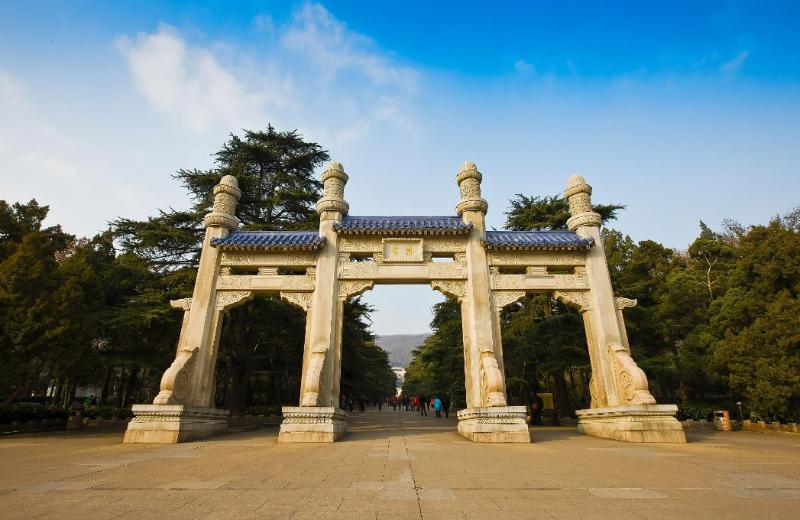Sun Yat-sen Mausoleum

Nanjing: Sun Yat-sen Mausoleum
Nanjing, historically known as Jinling, is an ancient capital city with a rich cultural heritage and numerous historical sites. Among them, the Sun Yat-sen Mausoleum, as the tomb of Dr. Sun Yat-sen, is not only a significant historical relic in modern history, but also a symbol of the Chinese national spirit, attracting countless visitors to pay their respects.
I. The Architectural Style and Design of Sun Yat-sen Mausoleum
The design of Sun Yat-sen Mausoleum combines traditional Chinese architectural styles with modern Western architectural concepts, reflecting a "solemn, simple and straightforward" architectural style.
-
Overall Layout: The main body of the mausoleum is situated on the south slope of Purple Mountain, built along the mountainside, with distinct levels, majestic and grand. The entire mausoleum consists of four parts: the Sacred Way, the Stele Pavilion, the Memorial Hall and the Tomb, with a rigorous layout, symmetrical axis, reflecting the "harmony between man and nature" concept of traditional Chinese architecture.
-
The Sacred Way: The Sacred Way is composed of stone steps, platforms, and a triumphal arch, about 600 meters long. On both sides are planted tall cypresses, symbolizing Dr. Sun Yat-sen's noble character and great achievements. The stone steps have a total of 392 steps, symbolizing Dr. Sun Yat-sen's 392 years of life journey.
-
The Stele Pavilion: The Stele Pavilion is located in the middle section of the Sacred Way. Inside the pavilion stands a white marble statue of Dr. Sun Yat-sen. The front of the statue is inscribed with four large characters "天下为公" (The World for All), expressing Dr. Sun Yat-sen's lofty ideal of seeking happiness for all people under heaven.
-
The Memorial Hall: The Memorial Hall is the core building of the mausoleum, located at the end of the Sacred Way. It is a huge stone building with three golden characters "中山陵" (Sun Yat-sen Mausoleum) inscribed on the front. The Memorial Hall houses Dr. Sun Yat-sen's tomb, surrounded by various relics and historical photos, showcasing Dr. Sun Yat-sen's eventful life.
-
The Tomb: The Tomb is located underground in the Memorial Hall, being Dr. Sun Yat-sen's resting place. The Tomb is designed with simplicity and clarity, using white marble as the main material, symbolizing Dr. Sun Yat-sen's integrity and honesty.
II. The Historical Value and Cultural Significance of Sun Yat-sen Mausoleum
Sun Yat-sen Mausoleum is not only Dr. Sun Yat-sen's tomb but also a significant historical relic in modern Chinese history, carrying profound historical value and cultural significance.
-
Commemorating Dr. Sun Yat-sen: Sun Yat-sen Mausoleum is an important place to commemorate Dr. Sun Yat-sen's great achievements and promote his ideas. As a great pioneer of modern Chinese democracy, Dr. Sun Yat-sen led the Xinhai Revolution, overthrew the Qing dynasty, established the Republic of China, and made indelible contributions to the liberation of the Chinese people and the rejuvenation of the nation.
-
Symbol of National Spirit: Sun Yat-sen Mausoleum symbolizes the spirit of the great rejuvenation of the Chinese nation. Dr. Sun Yat-sen's revolutionary ideas and patriotism have inspired generations of Chinese people to strive for the Chinese Dream of national rejuvenation.
-
Passing on the Revolutionary Spirit: Sun Yat-sen Mausoleum is a place for passing on the revolutionary spirit. Every year, countless tourists come to pay their respects, commemorate Dr. Sun Yat-sen, learn his revolutionary spirit, draw strength from it, and contribute their own strength to the great rejuvenation of the Chinese nation.
III. The Tourism Value of Sun Yat-sen Mausoleum
As a significant historical and cultural relic, Sun Yat-sen Mausoleum has unique tourism value, attracting visitors from all over the world.
-
Historical and Cultural Value: Sun Yat-sen Mausoleum has significant historical and cultural value, being an important window to understanding modern Chinese history. Visitors can learn about Dr. Sun Yat-sen's life story, learn his revolutionary ideas and patriotism, and feel the ups and downs of the modern Chinese revolution by visiting the Mausoleum.
-
Architectural Art Value: The architectural design of Sun Yat-sen Mausoleum is ingenious, combining traditional Chinese architectural styles with modern Western architectural concepts, reflecting the cultural confidence and spirit of the times of the Chinese nation. Visitors can feel the fusion of Chinese traditional culture and modern civilization by appreciating the architectural art of Sun Yat-sen Mausoleum.
-
Leisure and Sightseeing Value: Sun Yat-sen Mausoleum is located on the south slope of the scenic Purple Mountain, with a beautiful environment and fresh air. Visitors can stroll along the Sacred Way, admire the cypresses on both sides, feel the tranquility of the mountains and forests, and enjoy a relaxing and enjoyable experience.
IV. Future Development of Sun Yat-sen Mausoleum
As a national-level key cultural relic protection unit, Sun Yat-sen Mausoleum will continue to strengthen protection and utilization, turning it into a comprehensive cultural and tourism destination integrating history and culture, tourism, and education.
-
Strengthening Cultural Relic Protection: Continue to strengthen the protection of cultural relics at Sun Yat-sen Mausoleum, conduct regular maintenance of architectural facilities, and ensure their safety and integrity.
-
Developing Tourism Resources: Develop tourism resources of Sun Yat-sen Mausoleum, improve infrastructure construction, enhance visitor experience, and attract more visitors to visit.
-
Carrying Out Educational Activities: Conduct various educational activities, promote Dr. Sun Yat-sen's revolutionary spirit, pass on the great rejuvenation spirit of the Chinese nation, and contribute to the realization of the great rejuvenation of the Chinese nation.
As a symbol of the Chinese national spirit, Sun Yat-sen Mausoleum will continue to attract countless visitors to pay their respects, playing an increasingly important role on the stage of history, contributing to the great rejuvenation of the Chinese nation.